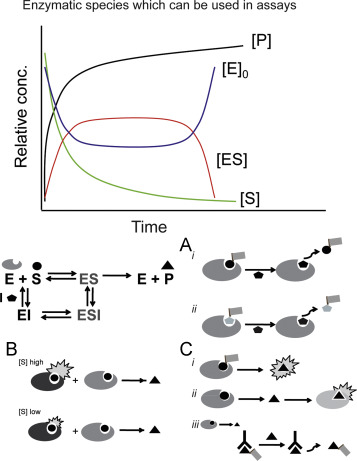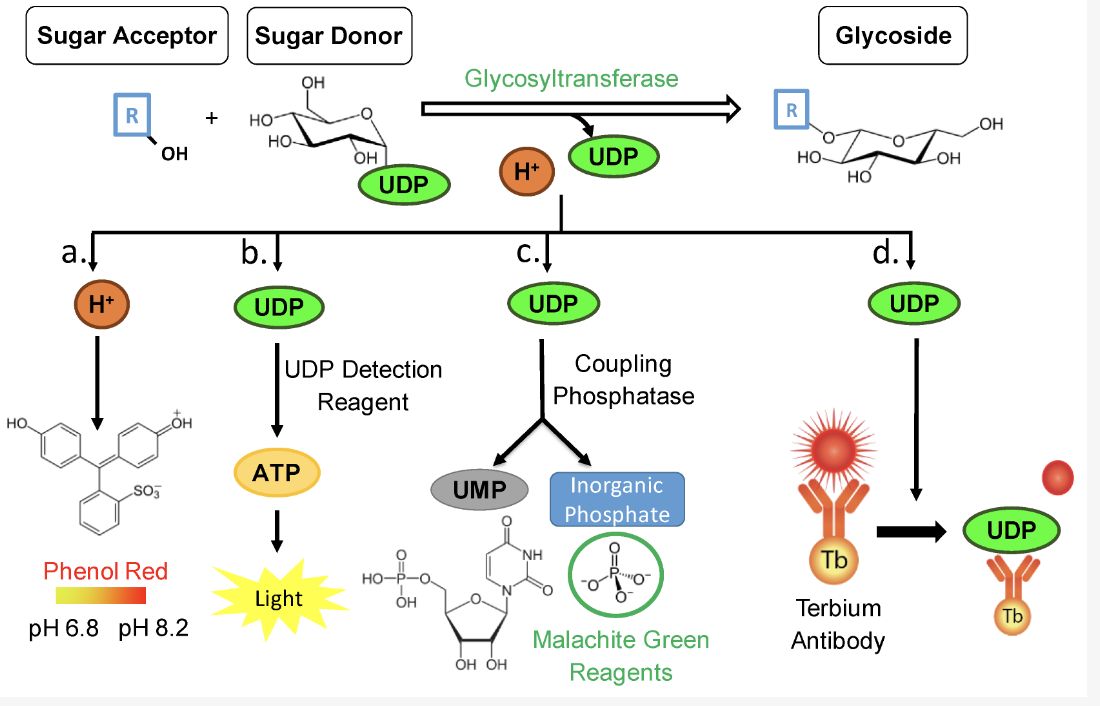High-Throughput Enzyme Assay Development is an efficient process used to examine the behavior and characteristics of enzymes. This innovative method enables the simultaneous analysis of numerous enzymes, significantly speeding up the discovery and development of new pharmaceuticals. Studying enzymes is crucial for understanding biological processes. It's vital for developing effective treatments for various diseases, as these biological catalysts play key roles in nearly all physiological reactions.
 Strategies of cell-free HTS assays for enzymes (Michael G. A. and Douglas S. A., 2014)
Strategies of cell-free HTS assays for enzymes (Michael G. A. and Douglas S. A., 2014)
Service Process
Our High-Throughput Enzyme Assay Development service follows a systematic and thorough procedure to ensure we provide the most comprehensive and accurate results. This process is broken down into four main steps, each crucial to the successful completion of the project.
- Consultation: Our first step involves a comprehensive consultation where we take the time to fully understand your project requirements and goals. Through in-depth discussions, we delve into the specifics of your needs, enabling us to formulate an effective strategy tailored to fulfill your objectives.
- Design: Following the initial consultation, we move on to the design phase where we meticulously develop a customized plan for the assay development. This bespoke plan is crafted to accommodate your unique requirements and objectives, ensuring that our approach aligns perfectly with your project needs.
- Implementation: Once the plan has been outlined, we transition into the implementation phase. The assays are conducted using state-of-the-art high-throughput methods. Leveraging our advanced automated systems, we're capable of processing a large number of assays simultaneously. This not only ensures efficiency but also guarantees consistency in our operations.
- Analysis: After the completion of the assays, we proceed to the analysis stage. Here, we thoroughly analyze the results of the assays and produce a detailed report. This comprehensive report encapsulates our findings and interpretations, equipping you with insightful data and valuable information essential for the progression of your project.
We're here to assist you. If you have any questions, need more information, or would like to discuss a potential project, please don't hesitate to contact us. Our team is always eager to help and share our expertise.
Applications
| Application |
Description |
| Drug Discovery |
High-Throughput (HTP) Enzyme Assay Development plays a pivotal role in drug discovery processes, serving as a powerful tool for screening a large number of compounds to identify those with potential enzyme activity. By automating and miniaturizing the assay procedure, HTP methods enable researchers to rapidly assess the efficacy of candidate drugs against specific enzyme targets, accelerating the drug development timeline. This approach is particularly valuable in early-stage drug discovery, where the identification of lead compounds with desirable pharmacological properties is paramount. |
| Biochemical Research |
In biochemical research, HTP Enzyme Assay Development facilitates the rapid screening of enzyme kinetics, substrate specificity, and inhibition mechanisms. By employing automation and miniaturization techniques, researchers can efficiently explore the biochemical properties of enzymes under various conditions. These assays provide insights into enzyme-substrate interactions, enzyme regulation, and potential therapeutic interventions targeting specific enzymes. The high-throughput nature of these assays allows for the simultaneous evaluation of multiple parameters, enhancing the efficiency and depth of biochemical studies. |
| Biotechnology |
HTP Enzyme Assay Development is integral to biotechnology applications, where enzymes play key roles in various industrial processes. By implementing high-throughput screening methods, biotechnologists can rapidly assess enzyme activities and optimize conditions for enzyme-mediated reactions. This accelerates the development of biocatalysts for applications such as biofuel production, bioremediation, and pharmaceutical synthesis. HTP assays also enable the discovery of novel enzymes with desirable properties, expanding the repertoire of biotechnological tools available for industrial and environmental applications. |
| Diagnostic Assays |
HTP Enzyme Assay Development is instrumental in the development of diagnostic assays for detecting enzyme biomarkers associated with various diseases and conditions. These assays enable the sensitive and specific detection of enzyme activity levels in clinical samples, providing valuable insights into disease diagnosis, prognosis, and treatment response. By leveraging high-throughput techniques, researchers can screen large patient cohorts efficiently, facilitating biomarker discovery and validation. Diagnostic assays based on HTP Enzyme Assay Development have applications across a wide range of medical specialties, including oncology, cardiology, and infectious diseases. |
| Pharmacogenomics |
HTP Enzyme Assay Development contributes significantly to pharmacogenomics research by enabling the study of enzyme polymorphisms and their effects on drug metabolism and response. These assays allow researchers to assess the functional consequences of genetic variations in drug-metabolizing enzymes, such as cytochrome P450 enzymes, UDP-glucuronosyltransferases, and drug transporters. By screening large populations for enzyme activity phenotypes, pharmacogenomic studies can identify individuals at increased risk of adverse drug reactions or poor therapeutic outcomes, leading to personalized medication regimens tailored to individual genetic profiles. HTP methods also support the discovery of novel drug targets and the development of enzyme-based therapies for precision medicine applications. |
| Food Industry |
HTP Enzyme Assay Development plays a crucial role in the food industry, where enzymes are utilized in various processes such as food processing, quality control, and preservation. By implementing high-throughput screening methods, food scientists can assess enzyme activities in raw materials, intermediate products, and finished goods, ensuring product quality and safety. HTP assays enable the rapid detection of enzyme contaminants, spoilage organisms, and pathogens, facilitating timely interventions to prevent foodborne illnesses and product recalls. Additionally, these assays support research and development efforts aimed at improving food processing techniques, enhancing nutritional quality, and extending shelf life through enzymatic modifications. |
| Environmental Testing |
HTP Enzyme Assay Development finds diverse applications in environmental testing, where enzymes serve as sensitive indicators of ecosystem health and pollution. By measuring enzyme activities in environmental samples, researchers can assess the impact of pollutants on biological processes and ecosystem functioning. These assays provide valuable information for environmental monitoring, pollution remediation, and risk assessment. HTP methods enable the rapid analysis of large numbers of samples, allowing for comprehensive surveys of environmental enzyme activities across different habitats and pollution gradients. |
Case Study
Glycosylation, catalyzed by UGTs, yields glycosylated products along with byproducts like a proton from the acceptor molecule and the free UDP molecule from the sugar donor. The figure below illustrates the glycosyltransferase reaction mechanism, leading to glycoside formation. The quantity of by-products is detected by four different assays prone to be high-throughput (HTP). (a) Colorimetric pH-sensitive assay—the relationship between the amount of glycoside formed to the pH value is inversely proportional. (b) UDP-GloTM assay—UDP is converted to ATP which triggers a luciferase reaction and generates light. The relationship between the amount of glycoside formed to the amount of ATP detected is directly proportional. (c) Phosphate GT assay—a 2-step colorimetric assay utilizing phosphatase and malachite green reagents. The relationship between the amount of glycoside formed to the formation of phosphate is directly proportional. (d) UDP2 TR-FRET immunoassay—a competitive immunoassay for UDP with a far-red, TR-FRET readout. The relationship between the amount of glycoside formed to the FRET signal is inversely proportional.
 Comparative Analysis of High-Throughput Assays of Family-1 Plant Glycosyltransferases (Kate M. and Wilfried S., 2020)
Comparative Analysis of High-Throughput Assays of Family-1 Plant Glycosyltransferases (Kate M. and Wilfried S., 2020)
FAQs
Below are the most frequently asked questions about High-Throughput (HTP) Enzyme Assay Development, covering its definition, significance, process, application, types of enzymes studied, duration, accuracy, equipment used, and customization possibilities. If you have more specific or detailed questions, don't hesitate to get in touch with us directly.
Q: What precisely is an enzyme assay?
A: An enzyme assay is a specialized procedure designed to measure the activity of enzymes, the biological molecules responsible for thousands of metabolic processes in our bodies. The results provide valuable information about how these enzymes function and interact, which can be vital in developing new drugs and treatments.
Q: Why is high-throughput screening so important?
A: High-throughput screening is a cornerstone of modern pharmaceutical research. It allows for the simultaneous analysis of a multitude of enzymes, significantly speeding up the discovery and development of new drugs. It's what makes the HTP Enzyme Assay Development process so efficient and effective.
Q: How does the HTP Enzyme Assay Development process work?
A: The HTP Enzyme Assay Development process involves the large-scale execution of enzyme assays using automated systems. This automation allows for a high level of accuracy and consistency, as well as the ability to process large numbers of assays simultaneously.
Q: What can the results of HTP Enzyme Assay Development be used for?
A: The results obtained from HTP Enzyme Assay Development can have a wide range of applications. They can inform drug discovery and development, help understand disease processes, and contribute to our knowledge of biological systems.
Q: What kind of enzymes can be studied using HTP Enzyme Assay Development?
A: A wide variety of enzymes can be studied using HTP Enzyme Assay Development. This includes enzymes involved in disease processes, those used in industrial processes, and many others. The flexibility of the process allows it to be adapted to study virtually any enzyme of interest.
Q: How long does the HTP Enzyme Assay Development process take?
A: The time required for the HTP Enzyme Assay Development process can vary significantly, depending on the specifics of the project. Factors such as the number of enzymes to be studied, the complexity of the assays, and the level of detail required in the analysis can all influence the time taken.
Q: How accurate are the results of HTP Enzyme Assay Development?
A: HTP Enzyme Assay Development is designed to provide highly accurate and reliable results. The use of automated systems minimizes the risk of human error and ensures a high level of consistency across all assays.
Q: What kind of equipment is used in HTP Enzyme Assay Development?
A: HTP Enzyme Assay Development relies on the use of automated systems to conduct the assays. These high-tech systems are capable of handling large numbers of samples simultaneously, ensuring efficient and consistent results.
Q: Can HTP Enzyme Assay Development be customized to suit specific needs?
A: Absolutely! The HTP Enzyme Assay Development process can be tailored to suit the specific needs of your project. This means it can be adapted to study a wide range of enzymes and can be scaled to handle projects of almost any size.

































 Strategies of cell-free HTS assays for enzymes (Michael G. A. and Douglas S. A., 2014)
Strategies of cell-free HTS assays for enzymes (Michael G. A. and Douglas S. A., 2014) Comparative Analysis of High-Throughput Assays of Family-1 Plant Glycosyltransferases (Kate M. and Wilfried S., 2020)
Comparative Analysis of High-Throughput Assays of Family-1 Plant Glycosyltransferases (Kate M. and Wilfried S., 2020)